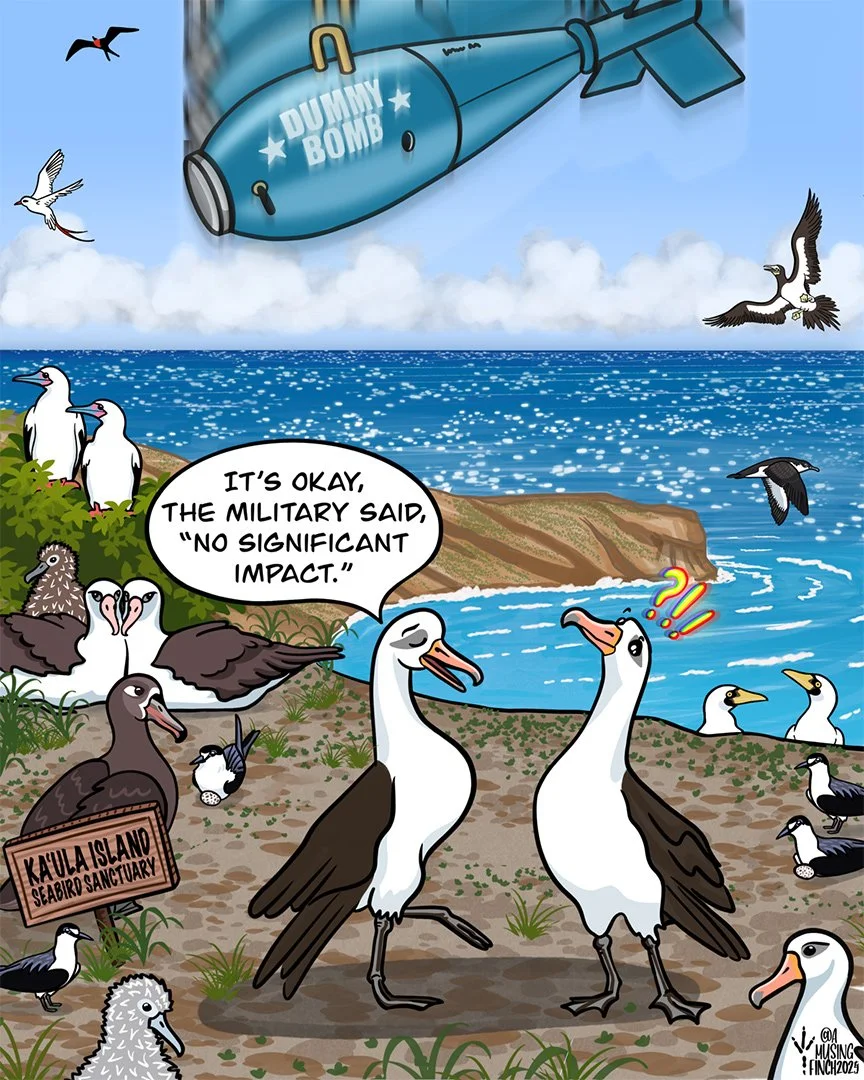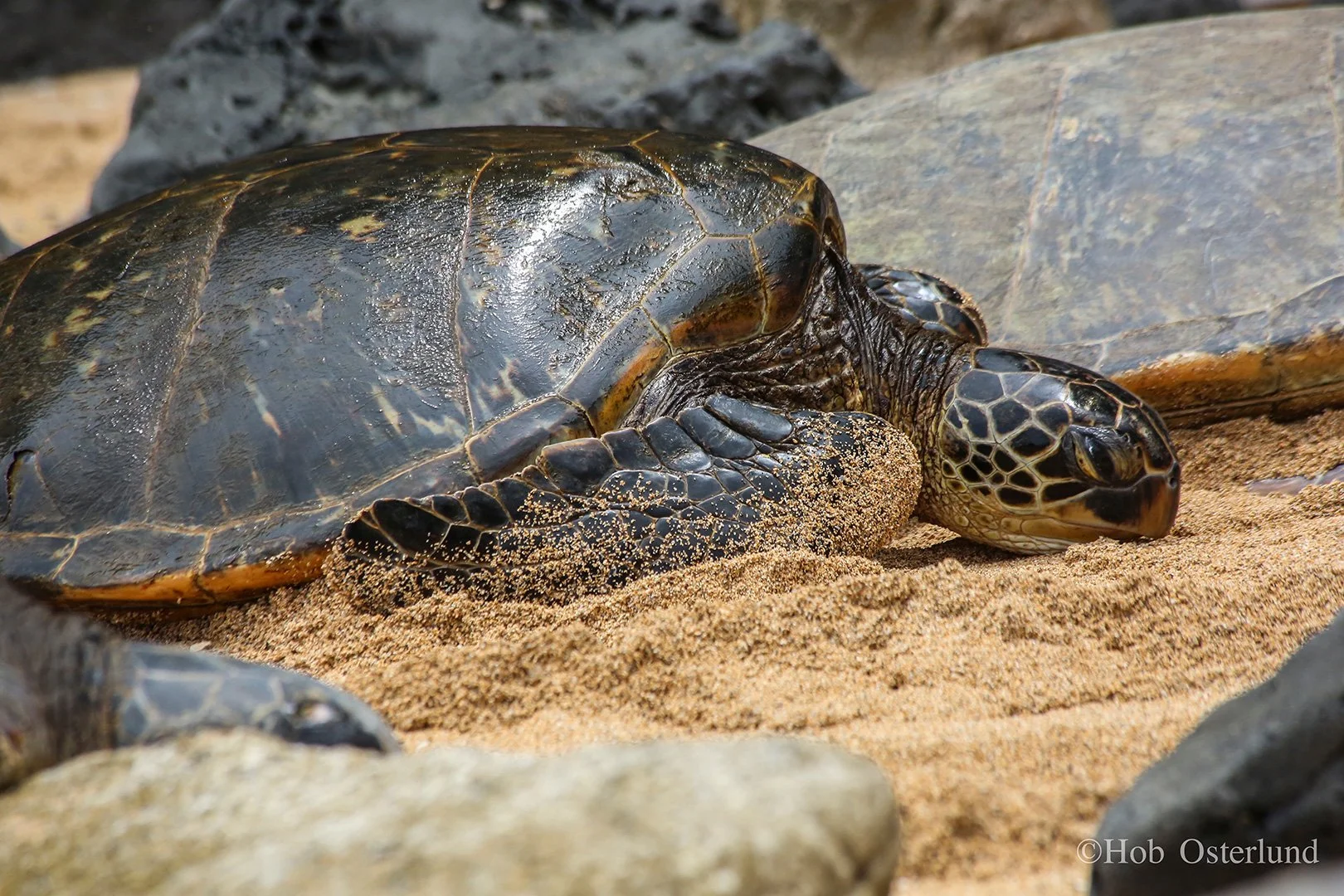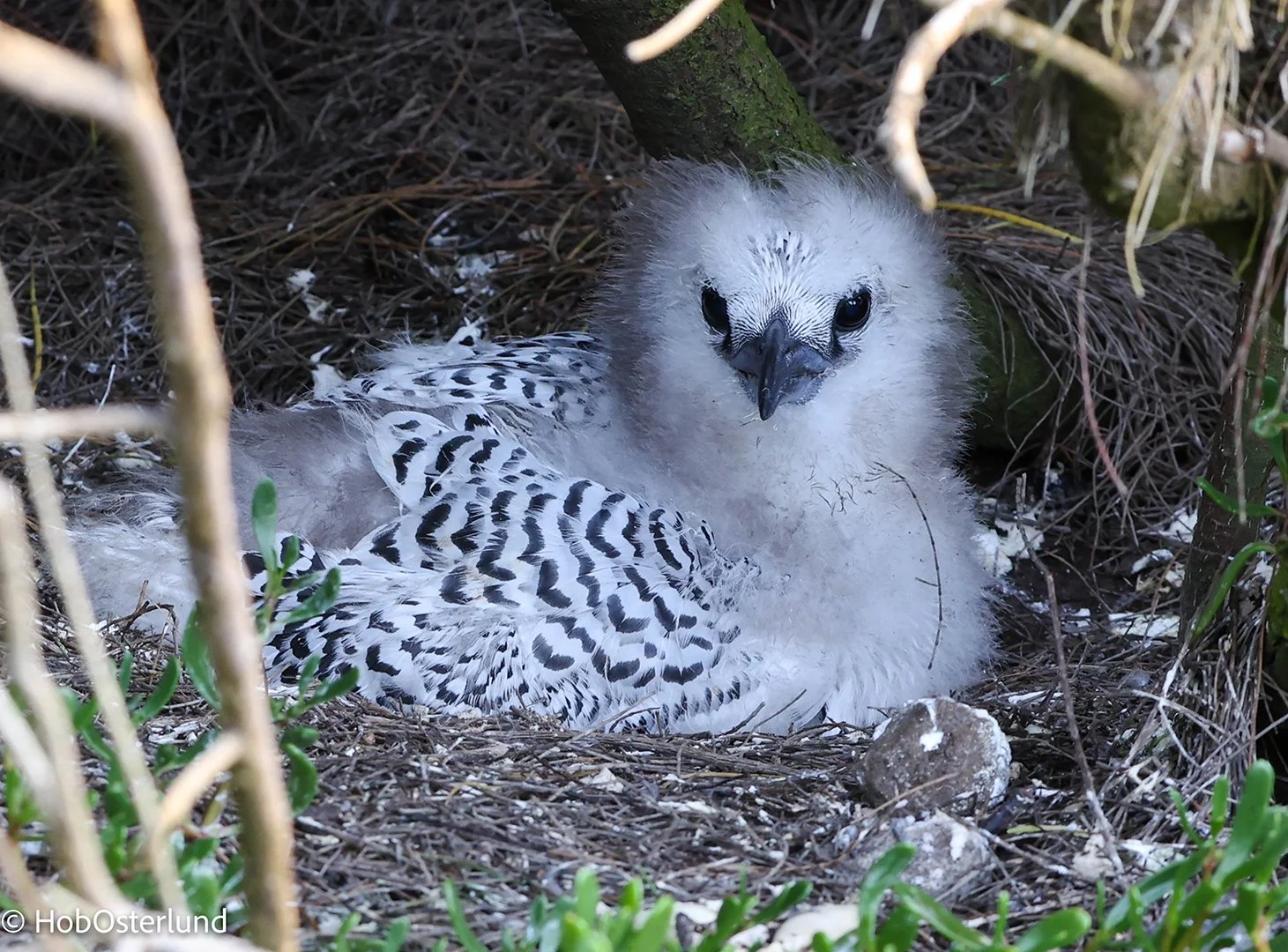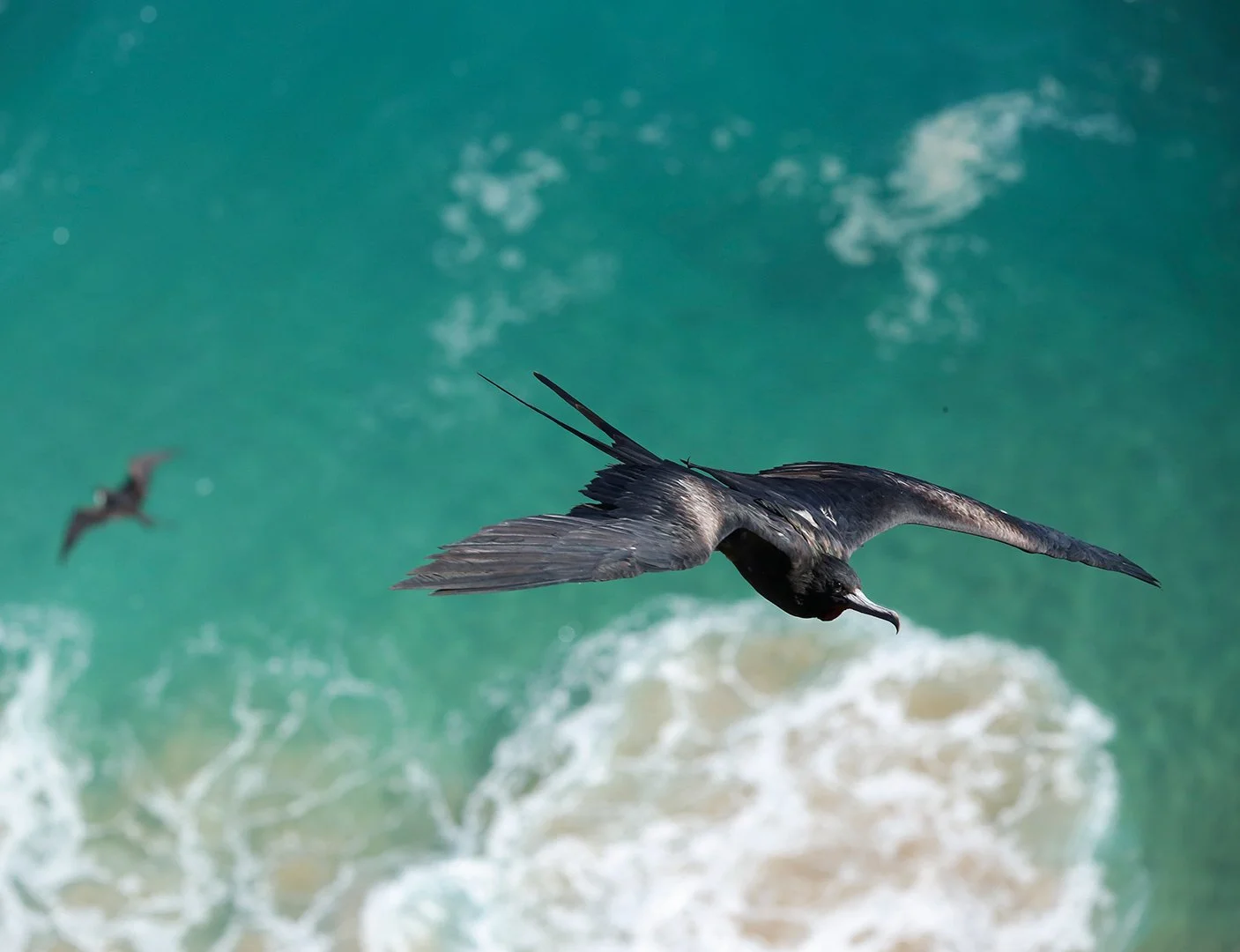Hawaiʻi Stands Up for Seabird Sanctuaries
By Safina Center Conservationist-in-Residence Hob Osterlund
Cartoon by Joanna Maney
In September of 2024, the United States Navy requested community support to bomb a small island in the County of Kauaʻi called Kaʻula Islet, which the State of Hawaiʻi had long since designated as a seabird sanctuary.
Actually, it turns out what the Navy really wanted was to increase bombing, which evidently had been going on since the 1950s. This came as a surprise to many (if not most) Hawaiʻi residents. The Navy proposed to nearly triple the current number of aerial bombings there, from twelve to as many as thirty-one per year.
The Navy’s Environmental Assessment (EA)—a much less rigorous evaluation than an Environmental Impact Statement (EIS)— concluded that the requested increase in “exercises” would not generate any major environmental repercussions. In the EA they suggested, without supporting evidence, that startled birds would simply fly away and later return.
The latter speculation completely ignored the fact that virtually all seabirds on Ka’ula are there for the purpose of nesting. Adult birds would either be sitting on eggs or young hatchlings, and startled take-offs can cause broken eggs or injured chicks. Young seabirds such as the mōlī (Laysan albatross) sit out in the open, without any means of protection or escape, until they can fly at five or six months of age.
A swift and resounding response came from countless people who testified against the bombing. Many conservation organizations immediately took issue with the fact that there had been no boots-on-the-ground seabird surveys in decades, that the Navy had not proven the absence or presence of any endangered species, and that they had provided no specific information about frequency or impact of previous bombings.
Because the Navy did not respond to these and many other concerns, Senators Brian Schatz and Mazie Hirono as well as Representatives Jill Tokuda and Ed Case—100% of Hawaii’s congressional delegation— collectively demanded answers and insisted that the Navy carry out a more detailed and rigorous EIS.
Hawaiian monk seal. ©Hob Osterlund
Honu (green sea turtle). ©Hob Osterlund
An EIS would require Navy officials to look more closely at how increased inert (non-explosive) bombing and gunfire might affect thousands of nesting seabirds and their chicks, not to mention monk seals and other abundant marine animals in surrounding waters.
Hawaiʻi’s congressional delegation asked the Navy to clarify: how vital the training exercises are to national security; whether those inert bombing runs could be replicated elsewhere; how reducing/stopping bombing altogether would impact readiness of military units in the U.S. Indo-Pacific Command; and whether the Navy has set aside money for environmental remediation and cleanup of both existing and future munitions on the islet.
The delegation also asked the Navy to clarify what plans it might have to keep the waters off Kaʻula open to Kauaʻi-based fishermen.
It’s not clear if or when the Navy will respond to these multiple questions.
Kalama (Johnston) Atoll
In March of 2025, the U.S. Air Force announced plans to build two landing pads on Johnston Atoll (AKA Kalama Atoll), a U.S. incorporated territory about seven hundred miles southwest of Honolulu. The atoll is within the Pacific Islands Heritage Marine National Monument. The plan has sparked fire from conservation groups because of the atollʻs importance to wildlife, especially the 1.5 million native seabirds of fifteen species who count on it for resting and nesting. Think one-third of the worldʻs red-tailed tropicbirds, think sooty terns. Think brown boobies, great frigatebirds, bristle-thighed curlews, Pacific golden plovers. Think 596 acres with 1.5 million birds, or—more easily imagined—the potential of 2,517 birds per acre.
ʻAlaeʻula (red-tailed tropicbird) chick. ©Hob Osterlund
Brown boobies. ©Hob Osterlund
But itʻs not only about birds. Think a myriad of ocean life, including three hundred species of fish and fifty types of coral. Think endangered species such as green sea turtles and Hawaiian monk seals.
The Air Force has proposed two landing pads built to allow ten reentry vehicle landings per year, for four consecutive years.
Elon Musk’s SpaceX Starship is evidently being considered for the project.
In response, the Center for Biological Diversity (CBD) filed suit against U.S. government agencies for failing to release public records on the specifics of its plans. The CBD filed its complaint in U.S. District Court in Hawaiʻi due to the failure of the U.S. Fish and Wildlife Service (USFWS) and Department of the Air Force to respond to Freedom of Information Act (FOIA) requests.
Maxx Phillips, CBDʻs Hawaiʻi and Pacific Islands Director, told The Garden Island News that landing and launching of massive rockets on one of the most isolated and valuable habitats for seabirds would be enormously destructive.
“That’s exactly why the military and SpaceX are trying to keep this project’s details hidden from the public,” she said. “This project threatens to destroy a site that more than a million native seabirds need for nesting and overwintering, all in the name of military logistics and Elon Musk’s profit.”
A male ʻiwa (great frigate bird). ©Hob Osterlund
In April of 2025 a draft EA was expected to be available for public review but was delayed for unknown reasons.
The CBD requested certain documents pertaining to the proposed construction due to the likelihood of major environmental impacts on essential fish habitat, migratory birds, and other protected species.
The thriving seabird population at Kalama today is only possible after years of efforts by the USFWS to eradicate invasive yellow crazy ants, which were causing seabird blindness, injury and death. The island has also been recovering from seventy years of military activities including nuclear testing and chemical weapon storage and disposal. In 2004 the military turned Kalama over to the USFWS to manage as a seabird sanctuary.
Now the U.S. Air Force wants Kalama for a project as part of a “rocket cargo vanguard” program exploring the use of commercial rockets for rapid global military cargo delivery.
The Pacific Islands Heritage Coalition called for a full EIS and submitted a petition with nearly four thousand signatures. The Center said SpaceX has had a history of insufficient environmental review and recurring harm to critical habitat on national wildlife refuge lands.
After one of SpaceXʻs previous rocket explosions, CBD along with the American Bird Conservancy and the Surfrider Foundation sued the Federal Aviation Administration.
When it comes to Kaʻula and Kalama, both seabird havens of the Pacific, one thing is clear: a collective of private citizens, elected officials and conservation organizations will not be sitting by in silence.
Long may they prevail.
Addendum: shortly after this blog was submitted, the U.S. Air Force announced suspension of plans for cargo rocket testing at Kalama (Johnston Atoll). This is great news. It also said the service will explore “alternative options for…the rocket cargo Vanguard program” at another location. This may or may not be great news. At potential risk are the Northwestern Hawaiian Islands, including Kuaihelani (Midway Atoll.)






